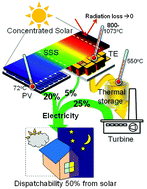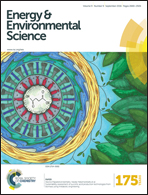Hybrid strategies and technologies for full spectrum solar conversion
Abstract
Harvesting the full spectrum of sunlight using a hybrid approach offers the potential for higher efficiencies, lower power production costs, and increased power grid compatibility than any single technology by itself. In this article, the base technologies for converting sunlight into electricity, including photovoltaics and solar thermal approaches are discussed. Then feasible strategies for combining them to utilize the various portions of the solar spectrum most effectively are discussed. In this study, we particularly focus on the advantages of a spectral splitting approach. This helps to convert higher energy photons (UV and visible) directly into electrons using optimized single or tandem photovoltaic (PV) cells, while capturing lower energy photons as heat using a selective solar absorber, which absorbs photons within a range of energies, down to a cutoff in the mid-infrared. The solar heat is then thermally concentrated and driven through a high temperature thermoelectric generator on top of a high efficiency mechanical engine (e.g., a steam-driven Rankine cycle) through a heat exchanger, which connects to both thermal storage and the mechanical engine at 550 °C. The thermal storage allows for significant flexibility in the time of power generation (also known as dispatchability) at a modest cost. Hence, the system can produce power for hours after sunset. Ideally, the system can achieve efficiencies over 50% using a combination of an InAlAs/InGaP tandem photovoltaics, ErAs:(InGaAs)1−x(InAlAs)x thermoelectrics, and mechanical Rankine cycles. The configuration and operating conditions can be optimized to minimize the levelized cost of energy (LCOE).


 Please wait while we load your content...
Please wait while we load your content...